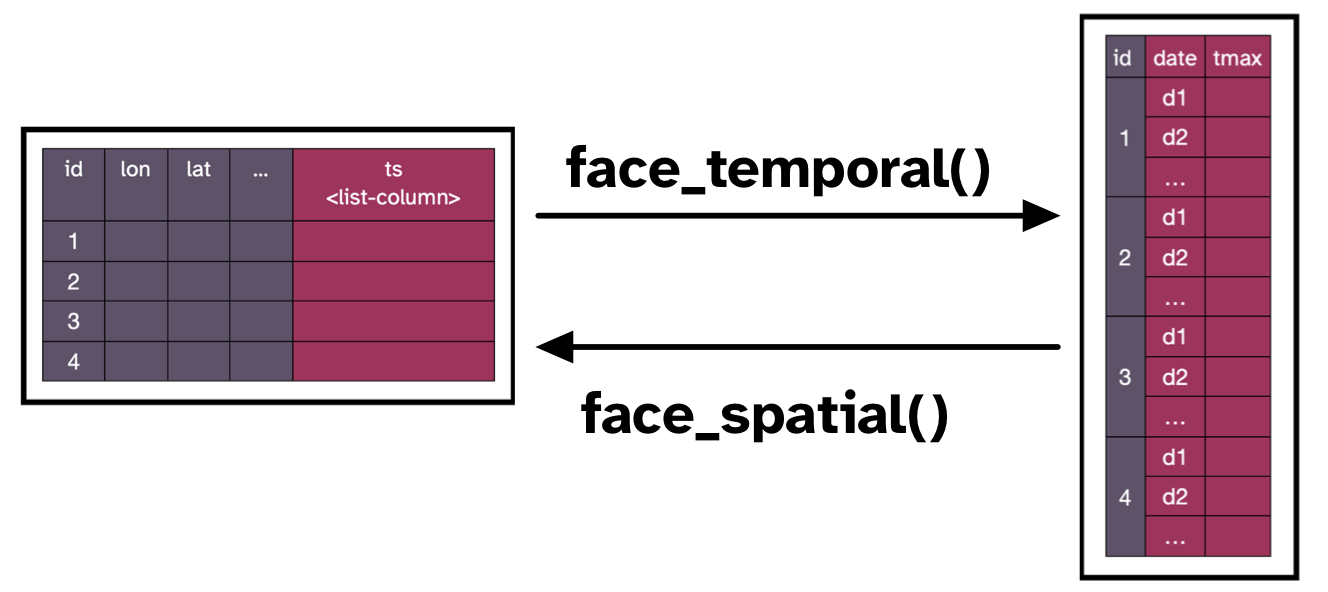The term spatio-temporal data can incorporate various spatial and temporal characteristics and different data may require different data structures for wrangling and analysis. The spatio-temporal data that cubble addresses are those collected at unique fixed locations, allowing for irregularity in the temporal dimension, such as the weather station data.
You can install the released version of cubble from CRAN with:
install.packages("cubble")And the development version from GitHub with:
# install.packages("remotes")
remotes::install_github("huizezhang-sherry/cubble")Cubble organises spatio-temporal data in two structures: In a nested
cubble (spatial cubble), spatial variables are organised as columns and
temporal variables are nested within a specialised ts
column:
#> # cubble: key: id [3], index: date, nested form
#> # spatial: [144.83, -37.98, 145.1, -37.67], Missing CRS!
#> # temporal: date [date], prcp [dbl], tmax [dbl], tmin [dbl]
#> id long lat elev name wmo_id ts
#> <chr> <dbl> <dbl> <dbl> <chr> <dbl> <list>
#> 1 ASN00086038 145. -37.7 78.4 essendon airport 95866 <tibble [10 × 4]>
#> 2 ASN00086077 145. -38.0 12.1 moorabbin airport 94870 <tibble [10 × 4]>
#> 3 ASN00086282 145. -37.7 113. melbourne airport 94866 <tibble [10 × 4]>In a long cubble (temporal cubble), the temporal variables are expanded into the long form, while the spatial variables are stored as a data attribute:
#> # cubble: key: id [3], index: date, long form
#> # temporal: 2020-01-01 -- 2020-01-10 [1D], no gaps
#> # spatial: long [dbl], lat [dbl], elev [dbl], name [chr], wmo_id [dbl]
#> id date prcp tmax tmin
#> <chr> <date> <dbl> <dbl> <dbl>
#> 1 ASN00086038 2020-01-01 0 26.8 11
#> 2 ASN00086038 2020-01-02 0 26.3 12.2
#> 3 ASN00086038 2020-01-03 0 34.5 12.7
#> 4 ASN00086038 2020-01-04 0 29.3 18.8
#> 5 ASN00086038 2020-01-05 18 16.1 12.5
#> 6 ASN00086038 2020-01-06 104 17.5 11.1
#> 7 ASN00086038 2020-01-07 14 20.7 12.1
#> 8 ASN00086038 2020-01-08 0 26.4 16.4
#> 9 ASN00086038 2020-01-09 0 33.1 17.4
#> 10 ASN00086038 2020-01-10 0 34 19.6
#> # ℹ 20 more rowsThe two forms can be pivoted back and forth with the pair of verb:
face_spatial() and face_temporal().
